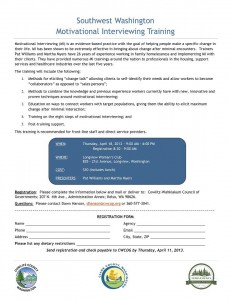 Print, Email or Share with the Share Button at the bottom of the page.
Print, Email or Share with the Share Button at the bottom of the page.
Notes by Summer D Clemenson
The spirit of Motivational Interviewing is to reflect a person’s conversation without offering advise or asking questions.
Four Aspects of MI:
- Partnership – Trust, rapport
- Acceptance – Accurate empathy
- Compassion
- Evocation
“They” are the expert of their own life.
Autonomy of self – You can make your own choice.
Twelve Roadblocks to Listening – by Thomas Gordon, PhD
- Ordering, directing or commanding
- Warning or threatening
- Giving advice, making suggestions or providing solutions
- Persuading with logic, arguing or lecturing
- Moralizing, preaching or telling clients what they “should do.”
- Disagreeing, judging, criticizing or blaming
- Agreeing, approving or praising
- Shaming, ridiculing or labeling
- Interpreting or analyzing
- Reassuring, sympathizing or consoling
- Questioning or probing
- Withdrawing, distracting, humoring or changing the subject
Processes of Motivational Interviewing
- Encouraging
- Focusing
- Evoking
- Planning
Ambivalence is solved by MI because as you reflect on the other person’s perspective.
Stages of Change
- Precontemplation – Nowhere near change
- Contemplation – Thinking about change
- Preparation – Planning, budgeting
- Action – We did it!
- Maintenance – Keeping up change & living with it while fulfilling obligations
- Relapse – Optional
The Goal: Change Talk Building
- Desire
- Ability
- Reason
- Need
- Commitments
- Activation – they are ready
- Taking – Action
- Steps
10 Strategies for Evoking Change Talk
1) Ask Evocative Questions
- Ask Open Questions: the answer to which is change talk
- Why would you want to make this change? (Desire)
- How might you go about it, in order to succeed? (Ability)
- What are the 3 best reasons for you to do it? (Reasons)
- How important is it for you to make this change? (Needs)
- So what do you think you will do? (Commitment)
2) Ask for Elaboration
- When change talk theme emerges, ask for more detail.
- “In what ways…?”
3) Ask for Examples
- When a change talk theme emerges, ask for specific examples.
- When was the last time that happened?
- Give me an example?
- What else?
4) Look Back
- Ask about a time before the current concern emerged.
- How were things better or different?
5) Look Forward
- Ask what may happen if things continue as they are (status quo).
- If you were 100% successful in making the change you want, what would be different?
- How would you like you life to be five years from now?
6) Query Extremes
- What are the worst things that might happen if you don’t make this change?
- What are the best things that might happen if you do make this change?
7) Use Change Rulers
- On a scale from 0-10, how important is it to you to target change (where is 0 is not important at all and 10 is vital). (Need)
- Follow up – “And why are you at ___ and not zero?
- What might happen that could move you from ___ to a (a higher score)?
- How much to you want… (Desire)
- How confident that you could… (Ability)
- How committed are you to… (Commitment)
- Note: “How ready are you?” Tends to be confusing because it intermingles desire, ability, reasons and need.
8) Explore Goals and Values
- What are the person’s guiding values? What do they want?
9) Come Alongside
- Side with the negative side.
- Perhaps if ___ is so important to you then you wont give it up.
10) Tune Your Ears to Change Talk – When you hear change, start mining for more.
The following material is based to some degree on Motivational Interviewing 2nd edition, by William R. Miller and Stephen Rollnick, 2002, Guilford Press. May be copied and used for educational purposes ONLY in its original form. Includes contributions by Dee-Dee Stout, Matt Kowalski and Rhonda Mckillip
Open Ended Questions
- What makes you think it might be time for a change?
- Please tell me more about that.
- How can I help you feel safer?
- What would you like to accomplish today?
- What was that like for you?
- How were you feeling after that?
- What would have to happen in order for things to be different next time?
- Tell me about your goals in this area.
- What questions should I ask?
- What would you like to do next?
- Describe an ideal outcome for this situation.
- What happened?
- How would you like to proceed?
- What is another way to say that?
Affirmations
Affirmations are statements we make to show our appreciation for what the client is going through or that we understand the experience they are describing. They are definitely not compliments and we should do our best to not begin with “I am…” statements.
- Wow, that must have been…
- You showed a lot of ____ by doing that.
- This demonstrated your commitment…
- Sounds like that wasn’t easy, but was worth the effort?
- You are committed to this course of direction
- It sounds like you honored your value of…
- Overcoming _____ is extremely difficult. You must have worked hard at it.
- That took a lot of courage.
Affirmations are NOT meant to be filler or “sugar coated” reflections. They must be heartfelt and recognize the importance of developing autonomy.
Reflections
There are multiple types of reflection. Learning to complexify reflections is the key to evoking change talk. A great thing about reflections is that practice builds competency and if you make an incorrect reflection, the client almost always corrects you – helping you to better understand how you can effectively serve them.
Simple reflections/parroting: tells your clients that you understand the meaning of their words.
Example:
- Client: I don’t really have an alcohol problem. I just have to manage all this anxiety when I’m at work.
- Listener: The real reason that you drink is because you feel anxious at work.
Amplified reflections: taking what the client has said and adding a bit (taking a guess at what has been left unsaid but is important).
Example:
- Client: I’m mellow after I have some weed. I don’t mind if people hand out afterward, I just wish they would value my privacy.
- Listener: You like to party with your friends but its hard to understand why friends don’t respect you and your home.
Double sided reflections: these actually reflect ambivalence and if correct they lay the foundation for change talk.
Example:
- Client: I wouldn’t even work there if I could find a better job.
- Listener: On the one hand you like the benefits and the pay but on the other hand you feel like you are trapped because there is no opportunity for advancement.
OR
- On the one hand you know you have to work to pay the bills but on the other hand you feel like your efforts aren’t appreciated.
Summarizing
Summarizing helps you by making sure that you’ve heard everything the client feels is important in the way which the client sees it. Summarizing shows that you are truly listening and can build trust.
- To summarize what we have been discussing…
- So far you have told me…
- OK, let me make sure that I’m hearing you clearly…
Then end the summary with a question or statement which gives the client a chance to agree or make corrections.
- Is that right?
- Have I got it?
- Am I hearing you correctly?
- Is there anything more I should know?
